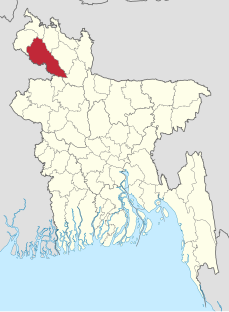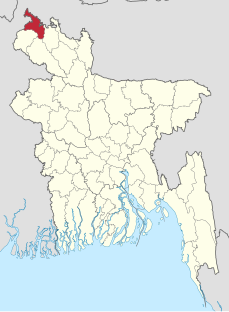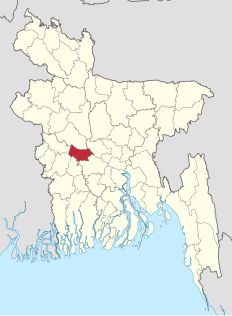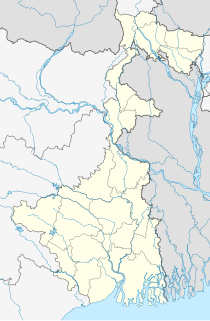
Natore is a district of Rajshahi Division located in northern Bangladesh. It borders the metropolitan city of Rajshahi, and used to be part of Rajshahi district.

Manikganj is a district in central Bangladesh. It is a part of the Dhaka Division.

Lakshmipur (Bengali: লক্ষ্মীপুর, romanized: Lokkhipur, also spelt Laxmipur, with an area of 1455.96 km2, is a district of Bangladesh. It is bordered by Chandpur to the north, Bhola and Noakhali districts to the south, Noakhali to the east, and Barisal and Bhola districts to the west.

Dinajpur district is a district in the Rangpur Division of northern Bangladesh. Dinajpur is the largest district among all sixteen northern districts of Bangladesh.

Panchagarh is a district of the Rangpur division in Northern Bangladesh. Panchagarh is the northernmost district of Bangladesh. It lies between 26º00' and 26º38' north latitudes and between 88º19' and 88º49' east longitudes. It was established as a district on 1 February 1984.

Sirajganj is a district in north-central Bangladesh, located in the Rajshahi Division.

Rajbari is a district in central Bangladesh, located in the Dhaka Division. It is a part of the Greater Faridpur subregion of Bengal due to the historical, linguistic and cultural identities of its inhabitants.

Fatullah is a town and an Union in Narayanganj Sadar Upazila in Narayanganj District. It is located on the southern outskirts of Dhaka, in central Bangladesh.

Baniachong is an upazila of Habiganj District in the Division of Sylhet, Bangladesh. Village Baniyachong is the biggest village in Asia.

Kulaura is the biggest upazila (subdistrict) of the Moulvibazar District in north-eastern Bangladesh. The total area of this upazila is 545 km2. Hakaluki Haor, the largest marsh wetland in Sylhet and one of the largest in Bangladesh is partially located there.

Keraniganj is an upazila of Dhaka District in the division of Dhaka, Bangladesh.

Palash is an upazila of the Dhaka Division of Bangladesh. It is the smallest upazila (sub-district) of Narsingdi District. Urban Palash is a part of Greater Dhaka; the conurbation surrounding the Bangladeshi capital city of Dhaka.

Gabtali is an upazila of the Bogra District, located in Bangladesh's Rajshahi Division. It is named after its administrative centre, the town of Gabtali and is best known as the home upazila of Ziaur Rahman, a former President of Bangladesh. Gabtali town is 7 km north of Bogra.

Dinajpur Sadar is an upazila of Dinajpur District in the Division of Rangpur, Bangladesh.

Hemchandra Chowdhury (1833-1915) was a Hindu Zamindar in Gopalpur Upazila in Tangail in what is now Bangladesh.

Gangarampur is a community development block that forms an administrative division in Gangarampur subdivision of Dakshin Dinajpur district in the Indian state of West Bengal.

Zamindars of Natore were influential aristocratic Bengali Zamindars, who owned large estates in what is today Natore District in Bangladesh.

Mohadevpur is an Upazila of Naogaon in the Division of Rajshahi, Bangladesh.
Moinuddin Ahmed Chowdhury was a politician in East Pakistan, social benefactor, and member of the Ghugudanga Zamindar family.

Matlab Uttar is an upazila of Chandpur District in the Division of Chittagong, Bangladesh. The former Matlab Upazila was divided into two in 2000, Matlab Dakshin and Matlab Uttar.












